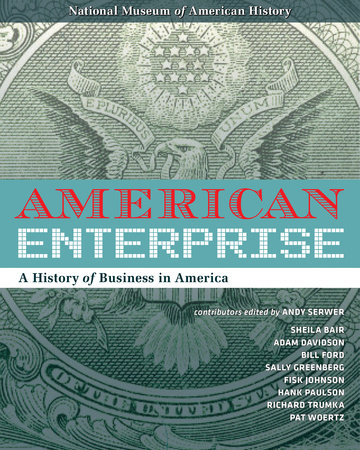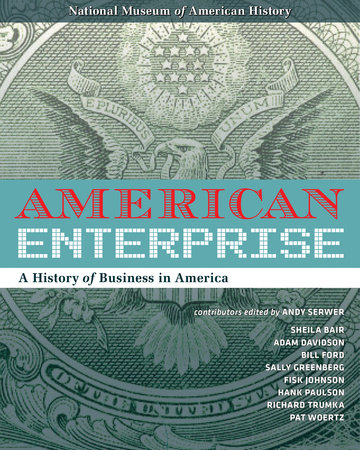

American Enterprise
Introduction by David K. Allison
Edited by Andy Serwer
Contributions by Peter Liebhold, Nancy Davis and Kathleen G. Franz
Introduction by David K. Allison
Edited by Andy Serwer
Contributions by Peter Liebhold, Nancy Davis and Kathleen G. Franz
Introduction by David K. Allison
Edited by Andy Serwer
Contributions by Peter Liebhold, Nancy Davis and Kathleen G. Franz
Introduction by David K. Allison
Edited by Andy Serwer
Contributions by Peter Liebhold, Nancy Davis and Kathleen G. Franz
Category: U.S. History | Economics | Science & Technology
Category: U.S. History | Economics | Science & Technology

-
$29.95
May 26, 2015 | ISBN 9781588344960
-
May 26, 2015 | ISBN 9781588344977
YOU MAY ALSO LIKE

Indianapolis Motor Speedway

Funny Face!

Slug Bread and Beheaded Thistles

Coal Black Heart
Praise
KIRKUS REVIEW
The Smithsonian’s National Museum of American History provides an illustrated overview of the country’s business history, including images of objects and artifacts in the museum’s collections.
The editors, Serwer, a former editor at Fortune magazine, and Liebhold, a curator at the museum, are joined by eight contributors from business, commerce, finance and government service. These include former treasury secretary and Goldman Sachs veteran Hank Paulson, Richard Trumka of the United Mine Workers Union, Bill Ford of the motor company, and Fisk Johnson, the fifth generation of the family in charge of SC Johnson. The editors identify four successive phases of business organization. Small businessmen and family businesses organized around trades and crafts characterized the Merchant Era, from 1770 to the 1850s. The Corporate Era (1860s-1930s) was based on the growth of industrialization, increasing capital and power, investors and limited liability. Contributor Adam Davidson, of the New York Times Magazine, writes that this period “represents a defining break between an old way of living and the new one we now know.” The editors divide the decades from the close of World War II to the present between the Consumer Era and the Global Era. The book covers the proliferation of slavery and the China trade, along with the development of the oil industry, advertising and the explosive rise of digital technology in the past few decades. The most interesting parts of the narrative are the pictures of the objects in the museum’s collection—e.g., a Singer sewing machine, an Underwood typewriter, a Bell telephone, a 1914 cash register from Marshall Field & Company in Detroit and a DuMont “Revere” entertainment center from 1947. Paulson concludes with a two-part contribution on global warming, noting that even though “we can see the crash coming…we’re sitting on our hands instead of altering course.”
An attractively presented guide and showcase to the museum and to business history.
21 Books You’ve Been Meaning to Read
Just for joining you’ll get personalized recommendations on your dashboard daily and features only for members.
Find Out More Join Now Sign In












